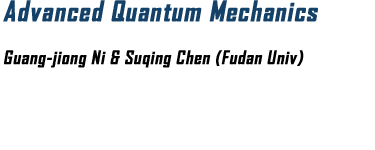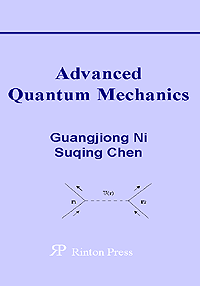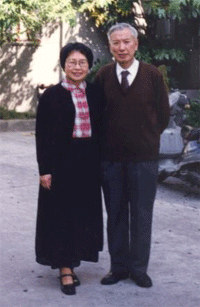| |

|
 |
|
 |
480 pages, 10x7 inches
April
2003 Hardcover
ISBN 1-58949-010-X
US$78 |
|
|
|
Buy It |
|
|
 
This book is based on lecture notes
developed in last twenty two years during which the
authors have been teaching a core graduate course,
Quantum Mechanics II, at Fudan University. It covers a
very broad range of topics, presenting the state of the
art in Quantum Mechanics. Discussions on some topics
such as Levinson theorem, Casimir effect, the essence of
special relativity, the interpretation of wave function,
geometric phase, fractional statistics, and paradoxes in
quantum mechanics, reflect to some extent the authors'
own research results. The book is profound, practical,
enlightening, and pleasantly readable. It is not only a
very good textbook for students majoring in theoretical,
experimental, or applied physics, but also a very useful
reference for researchers as well.

graduate
students, teachers, researchers in (both theoretical and
experimental) quantum physics. |

PREFACE.
CH.1. Basic Concepts and
Methods in Quantum Mechanics.
1.1. Spin system.
1.2. State vector, operator, matrix representation.
1.3. Configuration space representation, Wave function,
Schrodinger equation.
1.4. Simple harmonic oscillator.
1.5. Uncertainty relation in measurement.
1.6. Coherent state, squeezed state.
1.7. Path integral, Green function.
App.1a. Some theorems in operator algebra.
CH.2. Theory of Quantum
Scattering.
2.1. Rigorous solution for elastic scattering.
2.2. Born approximation.
2.3. Partial wave method.
2.4. Levinson theorem.
2.5. Scattering of low energy neutron with proton,
nuclear force.
2.6. Evolution operator and S matrix.
2.7. Transition probability, cross section.
2.8. Scattering and collision in two potentials.
2.9. Black nucleus model.
CH.3. Symmetries and Angular
Momentum in Quantum Mechanics.
3.1. Introduction.
3.2. Rotated state and rotated operator.
3.3. General properties of angular momentum operator.
3.4. Coupling of two angular momenta, Clebesh-Gordan
coefficient.
3.5. Matrix representation of rotation operator, D
function
3.6. Irreducible tensor operator, Wigner-Eckart theorem
and selection rules.
3.7. Symmetry and conservation law.
3.8. Space inversion, parity.
3.9. Time reversal symmetry.
CH.4. Quantization of
Electromagnetic Field and its Interaction with Charged
Particles.
4.1. Coulomb gauge of electromagnetic field, total
Hamiltonian of charged particle and electromagnetic
field.
4.2. Plane wave solution of free electromagnetic field
and its quantization.
4.3. Spherical wave solution of free electromagnetic
field and its quantization.
4.4. Transition probability of electromagnetic multipole
radiation. |
4.5.
Estimation of magnitude for electromagnetic
transition probability, selection rule.
4.6. Casimir effect.
CH.5. Density Matrix
and Quantum Statistics.
5.1. Density operator, ensemble.
5.2. Equation of motion for density matrix.
5.3. Polarization and scattering.
5.4. Introduction to quantum statistics.
CH.6. Phase in Quantum
Mechanics.
6.1. Electromagnetic potential, gauge
transformation.
6.2. Aharonov-Bohm effect, quantization of
magnetic flux.
6.3. Adiabatic approximation, Berry phase.
6.4. Geometric phase in two-state system.
CH.7. Motion of Electron in Magnetic Fields.
7.1. Landau energy-level and degeneracy.
7.2. Introduction to quantum Hall effect.
7.3. Introduction to fractional statistics
7.4. Theory of composite boson, composite
fermion.
7.5. Experimental discovery of fractional charge
in FQHE.
CH.8. Methods in Quantum Many Body Problems
and Applications.
8.1. Method of second quantization.
8.2. Hamiltonian in second quantization.
8.3. Bose-Einstein condensation.
8.4. Theory of superfluidity for liquid helium.
8.5. BCS Theory for Superconductivity.
CH.9. Relativistic Quantum Mechanics.
9.1. Relativistic wave equation.
9.2. K-G equation and coupling to
electromagnetic field.
9.3. Electron in electromagnetic field.
9.4. Klein paradox and anti-particle.
9.5. On the essense of special relativity.
9.6. Energy levels near the ground state of
Hydrogen atom.
App.9a. A semi-quantiative calculation of the
Lamb shift.
CH.10. Experiments and Interpretation of
Quantum Mechanics.
10.1. Wave-particle duality, complementary
principle, uncertainty relation.
10.2. Einstein-Podolsky-Rosen paradox and its
test in experiments.
10.3. Quantum theory and physical reality.
App.10a. Quantum teloportation.
App.10b. Experimental study on Schrodinger's cat
and its decoherence.
App. Convention units |
|

|
Guang-jiong Ni
is a Chair Professor of Physics in Fudan
University, Shanghai. He has been teaching in
Fudan for over 45 years and served as the
director of Modern Physics Institute and the
head of the Division for Theoretical Physics for
many years. His research areas include quantum
mechanics, field theory, and particle physics.
He is the author for over 170 papers published
in well known journals. Prof. Ni is a popular
writer of science in China. His books Modern
Physics (1979), Methods of Mathematical
Physics (1989), Levinson Theorem, Anomaly
and Phase Transition of Vacuum (1995),
Physics Changing the World (1998), and
Advanced Quantum Mechanics (2000) receive
very warm welcome from very broad range of
readers. He has received numerous rewards for
his research, teaching activities and book
writing. |
 Su-qing
Chen is a Professor of
Physics in Fudan University, Shanghai. Before
joining the Fudan faculty, she worked as a
researcher in Shanghai Institute for Nuclei,
mainly in the areas of nuclear theory, until
1978. In Fudan, Prof. Chen taught the courses
Quantum Mechanics and Group Theory
for many years. Her research work has been in
theoretical physics, with more than 20
publications. She is the co-author for two books
"Levinson Theorem , Anomaly and Phase
Transition of Vacuum " and "Advanced
Quantum Mechanics". The former had been
awarded the Science and Technology Progress
Prize by Education Ministry of China in 1999. Su-qing
Chen is a Professor of
Physics in Fudan University, Shanghai. Before
joining the Fudan faculty, she worked as a
researcher in Shanghai Institute for Nuclei,
mainly in the areas of nuclear theory, until
1978. In Fudan, Prof. Chen taught the courses
Quantum Mechanics and Group Theory
for many years. Her research work has been in
theoretical physics, with more than 20
publications. She is the co-author for two books
"Levinson Theorem , Anomaly and Phase
Transition of Vacuum " and "Advanced
Quantum Mechanics". The former had been
awarded the Science and Technology Progress
Prize by Education Ministry of China in 1999.
Su-qing married Guang-jiong in 1960, and they
have been living a very happy life together
since then.
|
|
|
|
|

